
I Corps is a corps of the United States Army headquartered in Joint Base Lewis-McChord, Washington. It is a major formation of United States Army Pacific (USARPAC) and its current mission involves administrative oversight of Army units in the Asia-Pacific region, including the Pacific Pathways program.

The 1st Commonwealth Division was the name given, after July 1951, to Commonwealth land forces in the Korean War. The division was a multinational unit that was part of British Commonwealth Forces Korea, and whilst British, Canadian Army and Australian infantry units formed the bulk of the division, New Zealand artillery and an Indian medical unit were also a part of the division. As with the US "KATUSA" programme, numerous South Korean troops were seconded to the Commonwealth division to make up numbers under a programme known as "KATCOM".

The 24th Infantry Division was an infantry division of the United States Army. It was inactivated in October 1996, it was based at Fort Stewart, Georgia and later reactivated at Fort Riley, Kansas. Formed during World War II from the disbanding Hawaiian Division, the division saw action throughout the Pacific theater, first fighting in New Guinea before landing on the Philippine islands of Leyte and Luzon, driving Japanese forces from them. Following the end of the war, the division participated in occupation duties in Japan, and was the first division to respond at the outbreak of the Korean War. For the first 18 months of the war, the division was heavily engaged on the front lines with North Korean and Chinese forces, suffering over 10,000 casualties. It was withdrawn from the front lines to the reserve force for the remainder of the war after the second battle for Wonju, but returned to Korea for patrol duty at the end of major combat operations.

IX Corps was a corps of the United States Army. For most of its operational history, IX Corps was headquartered in or around Japan and subordinate to US Army commands in the Far East.

Australia entered the Korean War on 28 September 1950, following the invasion of South Korea by North Korea. The war's origins began in the context of Japan's defeat in World War II which heralded the end to 35 years of Japanese occupation of the Korean Peninsula. The surrender of Japan to the Allied forces on 2 September 1945 led to the division of Korea into two countries, which were officially called the Democratic People's Republic of Korea (DPRK) and the Republic of Korea (ROK), with the DPRK was occupied by the Soviet Union, and the ROK, below the 38th Parallel, was occupied by the United States (US).
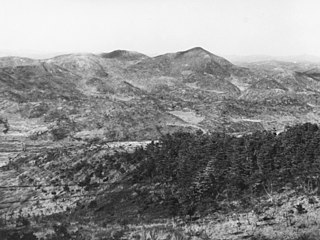
The First Battle of Maryang-san, also known as the Defensive Battle of Maliangshan, was fought during the Korean War between United Nations Command (UN) forces—primarily Australian and British—and the Chinese People's Volunteer Army (PVA). The fighting occurred during a limited UN offensive by US I Corps, codenamed Operation Commando. This offensive ultimately pushed the PVA back from the Imjin River to the Jamestown Line and destroyed elements of four PVA armies following heavy fighting. The much smaller battle at Maryang San took place over a five-day period, and saw the 3rd Battalion, Royal Australian Regiment dislodge a numerically superior PVA force from the tactically important Kowang san and Maryang san features, in conjunction with other units of the 1st Commonwealth Division.

The Battle of the Samichon River was fought during the final days of the Korean War between United Nations (UN) forces—primarily Australian and American—and the Chinese People's Volunteer Army (PVA). The fighting took place on a key position on the Jamestown Line known as "the Hook", and resulted in the defending UN troops, including the 2nd Battalion, Royal Australian Regiment from the 28th British Commonwealth Brigade and the US 7th Marine Regiment, repulsing numerous assaults by the PVA 137th Division during two concerted night attacks, inflicting numerous casualties on the PVA with heavy artillery and small-arms fire. The action was part of a larger, division-sized PVA attack against the US 1st Marine Division, with diversionary assaults mounted against the Australians. With the peace talks in Panmunjom reaching a conclusion, the Chinese had been eager to gain a last-minute victory over the UN forces, and the battle was the last of the war before the official signing of the Korean armistice.

The order of battle of Australian forces during the Korean War consisted of one, and later two infantry battalions, naval forces of one aircraft carrier, two destroyers, and one frigate, as well as air forces consisting of one fighter squadron and one transport squadron. The first forces were committed in July 1950 from units based in Japan as part of the British Commonwealth Occupation Force, with Australia being the first UN member nation after the United States to commit elements from all three services. A total of 17,808 Australians served during the Korean War, including 1,193 members of the Royal Australian Air Force (RAAF), 5,771 from the Royal Australian Navy (RAN), and 10,844 from the Australian Army, with casualties including 341 killed and 1,216 wounded. Australian forces remained following the end of hostilities, with the last units finally departing in 1956.
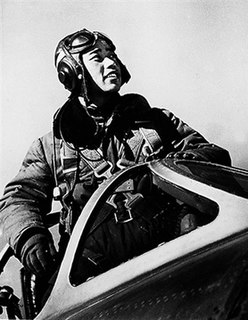
Zhao Baotong was a MiG-15 pilot of the People's Republic of China. He was a flying ace during the Korean War, with 9 victories.
Operation Polecharge was an offensive undertaken by United Nations Command (UN) forces during the Korean War between 15–19 October 1951, following on from the successful Operation Commando which established the Jamestown Line.
Operation Minden was an offensive undertaken by United Nations Command (UN) forces during the Korean War between 8–12 September 1951, as part of a general advance to extend the Wyoming Line, the UN Main line of resistance. Operation Minden was the precursor to the much larger Operation Commando, which established the Jamestown Line.

This is the order of battle for Chinese People's Volunteer Army during major periods of hostilities in the Korean War. After the People's Republic of China entered the Korean War in October 1950 by designating the People's Liberation Army (PLA) North East Frontier Force as the People's Volunteer Army (PVA), the PVA spent the next two years and nine months in combat operations and five years and three months in garrison duties. Its last elements did not leave Korea until as late as 1958.
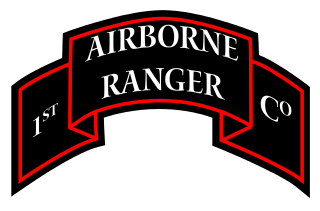
The 1st Ranger Infantry Company (Airborne) was a Ranger light infantry company of the United States Army active during the Korean War. As a small special forces unit, it specialized in irregular warfare.
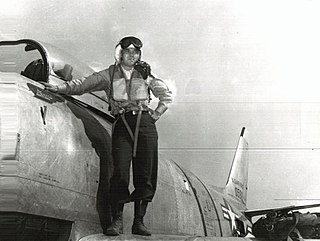
William Henry Wescott was a United States Air Force flying ace of the Korean War, credited with shooting down five enemy aircraft.
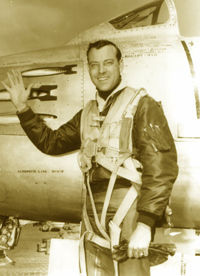
Robert Harold Moore was a United States Air Force flying ace of the Korean War, credited with shooting down five enemy aircraft in the war, all as a member of the 51st Fighter Interceptor Wing. Moore made his first kill on 28 October 1951 and fifth on 3 April 1952, all while flying the North American F-86 Sabre and all with the 16th Fighter Squadron except for one kill made with the 336th Fighter Squadron. He was the ninth American ace of the war.
Richard D. Creighton was a United States Air Force flying ace during the Korean War, shooting down five enemy aircraft in the war.
Stephen L. Bettinger was a United States Air Force flying ace during the Korean War, credited with shooting down five enemy aircraft.
Richard S. Becker was a United States Air Force flying ace during the Korean War, shooting down five enemy aircraft in the war.

Robert P. Baldwin was an Army Air Forces and United States Air Force pilot during World War II and Korea. He became a flying ace during the Korean War, shooting down five enemy aircraft.

The 3rd Ranger Infantry Company (Airborne) was a Ranger light infantry company of the United States Army active during the Korean War. As a small special forces unit, it specialized in irregular warfare.
















